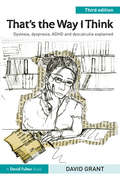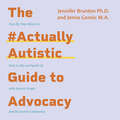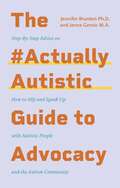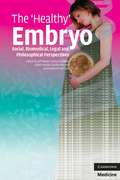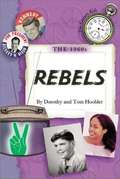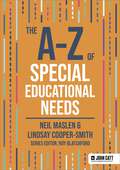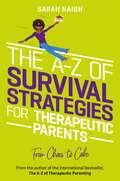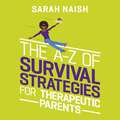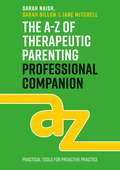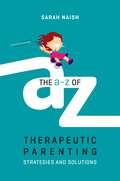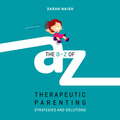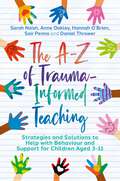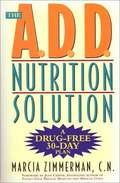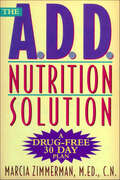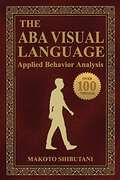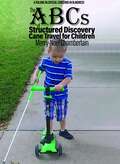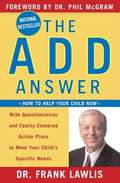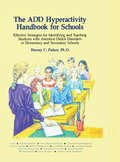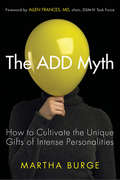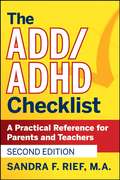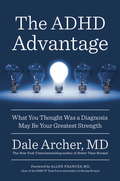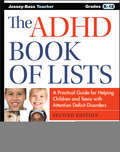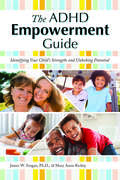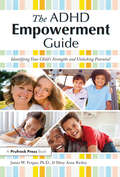- Table View
- List View
That's the Way I Think: Dyslexia, dyspraxia, ADHD and dyscalculia explained
by David GrantAbout 1 in 20 individuals are dyslexic. This figure also applies for dyspraxia and ADHD. This fully revised edition of David Grant’s thought-provoking, insightful book develops our understanding of these specific learning differences and considers the further challenges presented by these overlapping conditions. This new edition includes a brand-new chapter on dyscalculia. New sections also explore updates in the study of dyslexia, dyspraxia and ADHD as well as visualisation and synaesthesia, in the light of new data and research. These updates enable the reader to gain a fuller understanding of the sensory experiences and thoughts of individuals with specific learning differences. The author takes a life-style approach to explain many of the everyday experiences and choices of individuals with specific learning differences, including sleep, sports, visualisation and creativity, and uses real life examples explained in the words of those with specific learning differences. The accessible style of this book will immediately strike a chord with anyone with first or second-hand experience of specific learning differences. It is invaluable and insightful reading for those with specific learning differences as well as their parents and/or partner, teachers, teaching assistants and SENCos.
The #ActuallyAutistic Guide to Advocacy: Step-by-Step Advice on How to Ally and Speak Up with Autistic People and the Autism Community
by Jenna Gensic Jennifer BruntonThe #ActuallyAutistic Guide to Advocacy takes an in-depth look at the key elements of effective, respectful, inclusive advocacy and allyship. Every topic was chosen, shaped, and informed by #ActuallyAutistic perspectives.The step-by-step guide discusses various aspects of how autism is perceived, explores how best to speak up for individual needs, and introduces advocacy for the wider autistic community. Each step outlines one vital aspect of advocacy and allyship, such as emphasizing acceptance, avoiding assumptions and assuming competence. The advice and strategies laid out in this guide center the wisdom and experiences of Autistic people and enable the listener to confidently speak up with insight and understanding.(P) 2022 Jessica Kinglsey Publishers
The #ActuallyAutistic Guide to Advocacy: Step-by-Step Advice on How to Ally and Speak Up with Autistic People and the Autism Community
by Jenna Gensic Jennifer BruntonThe #ActuallyAutistic Guide to Advocacy takes an in-depth look at the key elements of effective, respectful, inclusive advocacy and allyship. Every topic was chosen, shaped, and informed by #ActuallyAutistic perspectives. The step-by-step guide discusses various aspects of how autism is perceived, explores how best to speak up for individual needs, and introduces advocacy for the wider autistic community. Each step outlines one vital aspect of advocacy and allyship, such as emphasizing acceptance, avoiding assumptions and assuming competence. The advice and strategies laid out in this guide center the wisdom and experiences of Autistic people and enable the reader to confidently speak up with insight and understanding.
The 'Healthy' Embryo: Social, Biomedical, Legal and Philosophical Perspectives
by Carolyn Mcleod Jeff Nisker Françoise Baylis Isabel Karpin Roxanne MykitiukThe ever-increasing use of assisted human reproduction technology and the use of human embryos to derive stem cells will ensure that the ethical, legal, and social issues explored in The 'Healthy' Embryo: Social, Biomedical, Legal and Philosophical Perspectives will remain the focus of public attention and subjects of debate and research across many academic disciplines.
The 1960's: Rebels
by Dorothy Hoobler Tom HooblerTHIS SEVENTH VOLUME OF THE Century Kids follows two rebels--in the best sense of the word. The first is Chuck, the great-great-grandson of the patriarch, Lionel Aldrich, whose family we have followed through five generations of the twentieth century. His rebellion, so typical of the decade, is against unfair authority. The second rebel is Sojie, who takes a stand against the established practice of the times as she returns with her mother to the South to participate in a lunch-counter demonstration demanding equal service for blacks. Both young people typify the awakening social consciousness that characterized the decade. AS IN THE EARLIER CENTURY KIDS volumes, the events and artifacts of the decade provide a backdrop for the narrative. The 1960s are a particularly inspiring decade with the growing success of Dr. Martin Luther King's nonviolent protest movement--yet it was a tragic decade as well, as young idealists grow to admire young President John F. Kennedy, only to see him brutally assassinated. IN ADDITION TO AN EXCITING STORY, the Hooblers provide an historical afterword, explaining some of the more interesting aspects of their research into the decade, as well as a timeline outlining what was going on in the world in which the story unfolds.
The A-Z of Special Educational Needs (John Catt A-Z series)
by Neil Maslen Lindsay Cooper-SmithThe A-Z of Special Educational Needs is a treasure trove of advice and guidance for SENCos, teachers, support staff and leaders, organised around the 26 letters of the English alphabet.'As teachers we all know pupils learn at different rates and require different levels and types of support at different points in their education in order to succeed. Skilful assessment allows teachers to ascertain what children know, what their barriers might be and what they need to learn next. Adapting teaching in a responsive way to this knowledge, by providing targeted support to pupils who are struggling, is likely to increase pupil success.' Neil Maslen & Lindsay Cooper-Smith
The A-Z of Special Educational Needs (John Catt A-Z series)
by Neil Maslen Lindsay Cooper-SmithThe A-Z of Special Educational Needs is a treasure trove of advice and guidance for SENCos, teachers, support staff and leaders, organised around the 26 letters of the English alphabet.'As teachers we all know pupils learn at different rates and require different levels and types of support at different points in their education in order to succeed. Skilful assessment allows teachers to ascertain what children know, what their barriers might be and what they need to learn next. Adapting teaching in a responsive way to this knowledge, by providing targeted support to pupils who are struggling, is likely to increase pupil success.' Neil Maslen & Lindsay Cooper-Smith
The A-Z of Survival Strategies for Therapeutic Parents: From Chaos to Cake (Therapeutic Parenting Books)
by Sarah Naish'This book is your hot flask of tea or coffee, and a cosy blanket which will keep you warm, safe and well on your journey, ensuring you reach the other side, mentally and physically well.'So, you want to help your child by therapeutic parenting, but how are YOU?This easy-to-follow, dip-in dip-out resource addresses common challenges and feelings experienced by therapeutic parents and offers 80 practical strategies to help you cope and survive. Bestselling parenting author Sarah Naish writes with humour and compassion, sharing her personal and professional experiences covering all of the essentials: self-maintenance, coping with isolation and rejection, scheduling holidays and, of course, the therapeutic importance of cake!Think you don't have the time or inclination for a bit of 'self-care'? This book will save time, save energy and help solve your problems - a 'must have' for all therapeutic parents.
The A-Z of Survival Strategies for Therapeutic Parents: From Chaos to Cake (Therapeutic Parenting Books)
by Sarah NaishAn A-Z of how to take care of YOU - survival strategies and solutions to common challenges faced by therapeutic parents.'This book is your hot flask of tea or coffee, and a cosy blanket which will keep you warm, safe and well on your journey, ensuring you reach the other side, mentally and physically well.'So, you want to help your child by therapeutic parenting, but how are YOU?This easy-to-follow, dip-in dip-out resource addresses common challenges and feelings experienced by therapeutic parents and offers 80 practical strategies to help you cope and survive. Bestselling parenting author Sarah Naish writes with humour and compassion, sharing her personal and professional experiences covering all of the essentials: self-maintenance, coping with isolation and rejection, scheduling holidays and, of course, the therapeutic importance of cake!Think you don't have the time or inclination for a bit of 'self-care'? This audiobook will save time, save energy and help solve your problems - a 'must have' for all therapeutic parents.(P) 2022 Jessica Kingsley Publishers
The A-Z of Therapeutic Parenting Professional Companion: Tools for Proactive Practice (Therapeutic Parenting Books)
by Sarah Naish Sarah Dillon Jane MitchellDesigned as a professional complement to Sarah Naish's bestselling A-Z of Therapeutic Parenting, this tried and tested resource offers practical tools for all professionals supporting therapeutic families.Based on the latest research, and with photocopiable worksheets, pro formas and charts to use with parents, these tools will help you to build supportive and stable relationships with families and reduce family breakdown.The resource is structured into three parts:1. The Trauma Tracker Tool - designed to support the stability of the family and to predict possible incidents by providing an understanding of the presenting behaviours in the context of the child's history2. The Developmental Foundation Planner - to help professionals to identify and address unmet developmental needs in a structured way as soon as a child is placed with a family and thereby help reduce instances of family breakdown3. The Behaviour - Assessment of Impact and Resolution Tool (BAIRT) - which enables practitioners of most levels to engage in a step by step intervention, breaking down the most complex behaviours with a problem solving supportive process, thereby reducing the effects of blocked care and enabling engagement with parents in an honest, positive process. Simple to use, and easy to implement, these tools will enable you to create therapeutic, trauma-informed assessments, intervention and support.
The A-Z of Therapeutic Parenting: Strategies and Solutions (Therapeutic Parenting Bks.)
by Sarah NaishTherapeutic parenting is a deeply nurturing parenting style, and is especially effective for children with attachment difficulties, or who experienced childhood trauma. This book provides everything you need to know in order to be able to effectively therapeutically parent. Providing a model of intervention, The A-Z of Therapeutic Parenting gives parents or caregivers an easy to follow process to use when responding to issues with their children. The following A-Z covers 60 common problems parents face, from acting aggressively to difficulties with sleep, with advice on what might trigger these issues, and how to respond. Easy to navigate and written in a straightforward style, this book is a 'must have' for all therapeutic parents.
The A-Z of Therapeutic Parenting: Strategies and Solutions (Therapeutic Parenting Books)
by Sarah NaishThe complete guide to therapeutic parenting, with an A-Z of applied advice for 60 common issuesTherapeutic parenting is a deeply nurturing parenting style, and is especially effective for children with attachment difficulties, or who experienced childhood trauma. This book provides everything you need to know in order to be able to effectively therapeutically parent.Providing a model of intervention, The A-Z of Therapeutic Parenting gives parents or caregivers an easy to follow process to use when responding to issues with their children. The following A-Z covers 60 common problems parents face, from acting aggressively to difficulties with sleep, with advice on what might trigger these issues, and how to respond.Easy to navigate and written in a straightforward style, this book is a 'must have' for all therapeutic parents.(P) 2019 Hodder & Stoughton Ltd
The A-Z of Trauma-Informed Teaching: Strategies and Solutions to Help with Behaviour and Support for Children Aged 3-11
by Sarah Naish Anne Oakley Hannah O'Brien Sair Penna Daniel Thrower"This is a remarkable achievement. Like Batman's Utility belt for teachers. So many practical, wise, inspiring, and achievable ideas are packed in here. I can imagine this becoming as indispensable for teachers as Gray's Anatomy is for doctors..." - Stephen Fry"If you want a book to assist with your work with traumatised children, choose this one. It is the best!" - Professor Peter Fonagy OBE, Chief Executive, Anna Freud National Centre for Children & Families"Humane and grounded in science, this book could change lives." - Sir Norman Lamb, Chair of Maudsley NHS and Children and Young People's Mental Health CoalitionWhat does trauma-informed teaching really look like in the classroom, and can we really achieve it?Maybe you, like many other teachers, will reach the end of a busy day feeling exhausted, deskilled and less than keen to dive into a book on the theory of trauma. Luckily you won't find any complex theory or jargon in this book, but you will gain an understanding of how small humans develop, how perplexing behaviours can be explained and learn inclusive strategies that will help all children in your classroom and school. Part 1 provides you with an explanation of what trauma-informed teaching involves. Then, Part 2 lists an A-Z of issues and behaviours for you to flip to in your busiest moments, ranging from Aggression and Lateness right through to Learning Challenges and Zzz (sleep issues). Gain new understanding into the children in your classroom with this book offering you strategies to better support every child's mental health and resilience.
The A. D. D. Nutrition Solution: A Drug-Free Thirty-Day Plan
by Marcia ZimmermanThe first scientifically proven, effective, all-natural nutritional alternative to the much-prescribed drug Ritalin. Attention deficit disorder is a nutritional deficiency, not a psychological condition. This is the revolutionary discovery Marcia Zimmerman made during her ten years of research as a nutritional biochemist. That conclusion led her to develop a diet that addresses the specific needs of the 17 million adults and children suffering from ADD. Her easy-to-follow thirty-day plan has been proven just as effective as Ritalin in relieving the symptoms of ADD. Learn: - How women should boost their nutrition before conception to prevent ADD in their children. - Why boys are much likelier to be tagged as ADD than girls - How to get a reliable ADD diagnosis Reasons why parents prefer a diet plan to prescription drugs for ADD children - The effects of brain allergies on attention span - Foods to avoid that may exacerbate ADD - Fats and oils we all need to stay focused - Calming effects of carbohydrates - Concentration-enhancing protein - Why to stay away from simple sugars - The dangers of artificial food ingredients, and much more This important book will help us curb the epidemic growth of ADD in this country and change the way we treat those who have it now by addressing its source instead of merely treating its symptoms.
The A.D.D. Nutrition Solution: A Drug-Free 30 Day Plan
by Marcia ZimmermanThe first scientifically proven, effective, all-natural nutritional alternative to the much-prescribed drug Ritalin Attention Deficit Disorder is a nutritional deficiency, not a psychological condition. This is the revolutionary discovery Marcia Zimmerman made during her ten years of research as a nutritional biochemist. That conclusion led her to develop a diet that addresses the specific needs of the 17 million adults and children suffering from ADD. Her easy-to-follow thirty-day plan has been proven just as effective as Ritalin in relieving the symptoms of ADD. Learn: - How women should boost their nutrition before conception to prevent ADD in their children.- Why boys are much likelier to be tagged as ADD than girls- How to get a reliable ADD diagnosis - The effects of brain allergies on attention span- Foods to avoid that may exacerbate ADD- The dangers of artificial food ingredients- and much moreThis important book will help us curb the epidemic growth of ADD in this country and change the way we treat those who have it now by addressing its source instead of merely treating its symptoms."This book is must reading for every parent, physician, teacher and school nurse who deals with ADD and AD/HD children. ADD is not caused by a deficiency of Ritalin. Marcia Zimmerman's The A.D.D. Nutrition Solutionis right on target!" -- Bernard Rimland, Ph.D., director of the Autism Research Institute, San Diego
The ABA Visual Language: Applied Behavior Analysis
by Makoto ShibutaniThis book describes various ABA terms with examples and illustrations. It is good for students who study ABA, people who are pursuing BCBA®, BCaBA®, or RBT®, people who use ABA for their profession, parents who are raising children with Autism and other related disorders, and anyone who is interested in learning ABA.
The ABCs of Structured Discovery Cane Travel for Children (Critical Concerns In Blindness)
by Merry-Noel ChamberlainStructured Discovery Cane Travel (SDCT) is an Orientation and Mobility (O&M) curriculum which focuses on the foundational techniques necessary to develop future independence for students who are blind or visually impaired. The ABCs of Structured Discovery Cane Travel for Children addresses essential non-visual concept development, techniques and mobility skills needed to travel efficiently, gracefully and safely within a myriad of natural environments while using the long, white cane with a metal tip as the primary mobility tool. This curriculum utilizes transformational knowledge and problem-solving opportunities through teachable moments to develop personal reflection and mental mapping which can be utilized post instruction. These students maximize their cognitive intrinsic feedback while completing everyday mobility tasks. Parents and instructors of children who are blind or visually impaired will comprehend the essentials of SDCT by reading The ABCs of Structured Discovery Cane Travel for Children; in addition, they will receive a treasure trove of O&M skill-building activities.
The ADD Answer: How to Help Your Child Now
by Frank LawlisEvery year, 17 million new cases of attention deficit disorder, or ADD, are diagnosed in children. But medications designed to treat the disorder don't work for many children and often leave families frustrated and searching for more options. In The ADD Answer, Dr. Frank Lawlis draws upon his thirty-five years of experience as a clinical and research psychologist to show parents how they can reclaim their central role in healing their children with comprehensive step-by-step advice on dealing with the problems of ADD. His approach blends the latest medical, nutritional, and psychological treatments that can increase brain function with expert insight into the emotional--and spiritual--support kids need. An inspiring and essential guide, The ADD Answer will help every family facing the challenges of ADD create a more loving, healthy environment necessary for their child to thrive.
The ADD Hyperactivity Handbook For Schools
by Harvey C. ParkerIf you've ever wanted to take dynamic and vibrant digital photos of your favorite band in concert, but aren't sure how to tackle such obstacles as approaching the stage, tricky lighting situations, or even what equipment to use, then look no further!Concert and Live Music Photographyis a comprehensive guide to shooting live music performances, providing you with the right information on equipment, camera settings, composition, and post-processing to get the best out of each performance shot. J. Dennis Thomas, whose work has appeared in such magazines as Rolling Stone, SPIN, and Country Weekly, shares tips on lighting, common problems, etiquette, and recommended camera settings for shooting in a variety of different venues, including clubs, bars, outdoor concerts, theatres, stadiums, and arenas. He also explains how to get the right credentials to get you closer to each performance.Jam packed with over160 photos from today's top concerts, this book will not only give you the information you need to start taking rockin' photos of your favorite musicians, but will spark your creativity when you're anticipating the next shot.For the on-the-go photographer, a cool companion website features additional tips, venue troubleshooting, and an equipment checklist when you need to think on your feet while running to another gig.
The ADD Myth: How to Cultivate the Unique Gifts of Intense Personalities
by Martha BurgeAn Alternative Approach to Addressing ADDDespite the millions of people taking medication for attention deficit disorders, there remains no objective method of diagnosis for ADHD. In The ADD Myth, Martha Burge proposes a different understanding and solution for those diagnosed.ADD isn’t what we think it is. Author and ADHD coach Martha Burge introduces a different way of looking at the disorder often associated with boredom and impulsivity in young people. She argues that what is commonly understood as ADHD is actually five intense personality traits: sensual, psychomotor, intellectual, creative, and emotional. Once the supposed ADD symptoms are properly understood for what they are, people with these intense personality traits can develop them into gifts.Finding an alternative solution. After having two sons diagnosed with ADHD, and witnessing their serious reaction to drug treatments, Martha began a search for a different approach and a more natural treatment for ADHD. By looking at all personalities as part of the neurodiversity spectrum, she shows us how we can see where those with “intense” personality traits fit on the spectrum. Once we understand that, we are better able to help people embrace their traits and develop one’s intense nature rather than try to stifle it.This book will change the way you look at ADD for the better—open it up and learn more about:The five intense personality traits and how they apply to individuals diagnosed with ADHDWhy the medical profession should seek alternative explanations for ADHDStories, practical steps, and daily practices for developing one's intense nature with the least amount of sufferingReaders of books such as Driven to Distraction, Healing ADD, Delivered from Distraction, or ADHD: Non-Medication Treatments and Skills for Children and Teens will enjoy The ADD Myth.
The ADD/ADHD Checklist
by Sandra F. RiefThe bestselling guide, fully revised and updated, offering practical information and tips to help every child with ADHD succeedThe ADD/ADHD Checklist helps parents and teachers to better understand children and teenagers with attention problems and provide the kind of support and intervention that is crucial to kids' success. Presented in a concise, easy-to-read checklist format, the book is packed with practical advice and information on a wide range of topics, including what we do and don't know about ADHD, probable causes, critical elements for school success, the most commonly prescribed medications, what children with ADHD need at home, effective behavioral strategies, how to help kids stay organized, and advocating for an ADHD child.
The ADHD Advantage
by Dale ArcherWhy ADHD could be the key to your successFor decades physicians delivered the diagnosis of ADHD to patients as bad news and warned them about a lifelong struggle of managing symptoms. But The ADHD Advantage explodes this outlook, showing that some of the most highly successful entrepreneurs, leaders, and entertainers have reached the pinnacle of success not in spite of their ADHD but because of it.Although the ADHD stereotype is someone who can't sit still, in reality people with ADHD are endlessly curious, often adventurous, willing to take smart risks, and unusually resilient. They are creative, visionary, and entrepreneurial. Sharing the stories of highly successful people with ADHD, Dr. Archer offers a vitally important and inspiring new way to recognize ADHD traits in oneself or in one's loved ones, and then leverage them to great advantage--without drugs.As someone who not only has ADHD himself but also has never used medication to treat it, Dr. Archer understands the condition from a unique standpoint. Armed with new science and research, he hopes to generate public interest and even debate with his positive message as he guides the millions of people with ADHD worldwide toward a whole new appreciation of their many strengths and full innate potential.
The ADHD Book of Lists
by Sandra F. RiefPractical ADHD management techniques for parents and teachers The ADHD Book of Lists is a comprehensive guide to ADHD/ADD, providing the answers parents, teachers, and other caregivers seek in a convenient list format. This new second edition has been updated with the latest research findings and resources, including the most up to date tools and strategies for helping these children succeed. Each aspect of ADHD/ADD is fully explained, from diagnosis to intervention, providing readers with the insight they need to make the best choices for the affected child. Coverage includes the latest medications and behavioral management techniques that work inside and outside the classroom, plus guidance toward alleviating individual struggles including inattention, impulsivity, executive function and subject-specific academic issues. Readers learn how to create a collaborative care team by bringing parents, teachers, doctors, therapists, and counselors on board to build a comprehensive management plan, as well as the practical techniques they can use every day to provide these children the support they need to be their very best. Attention Deficit/Hyperactivity Disorder cannot be cured, but it can be managed. Children with ADHD/ADD do not outgrow it, but the adults in their lives play a major role in what these children achieve and how they feel about themselves. This book is an insightful guide to supporting children with ADHD, and giving them the mental, emotional, and practical tools that boost their confidence and abilities. Investigate comprehensive treatments, including ADHD coaching Learn strategies for strengthening organization, working memory and other executive functions. Understand effective classroom management of students with ADHD Discover ways to help struggling children succeed despite the challenges There is a high correlation between ADHD and a number of negative outcomes when not treated, but the tide is turning as more effective management becomes commonplace. The ADHD Book of Lists is the complete easy-to-reference guide to practical ADHD management.
The ADHD Empowerment Guide: Identifying Your Child's Strengths and Unlocking Potential
by James Forgan Mary Anne RicheyThe ADHD Empowerment Guide is different from other parenting ADHD books because it helps parents identify their child's strengths to develop a specific plan to unlock their child's potential. Parents will complete two easy-to-follow questionnaires to identify their child's natural abilities, as well as determine key characteristics in their child that research has shown to help children with ADHD succeed in life. These characteristics include emotional control, integrity, grit, resiliency, resourcefulness, organization, motivation, school fit, support systems, and productive use of technology. Using the practical strategies presented, strength-building activities, and the information learned from the questionnaires, parents will create a success plan that will unlock their child's potential and build a positive outlook on the journey of raising a child with ADHD. The authors, two professionals who have "been there and done that" with their own children with ADHD, illustrate their strategies and content by highlighting successful people with ADHD who excelled in various areas and share some of their success secrets to raising a successful child with ADHD.
The ADHD Empowerment Guide: Identifying Your Child's Strengths and Unlocking Potential
by Mary Anne Richey James W. ForganRated one of the "Best ADHD Books of All Time" by Book Authority The ADHD Empowerment Guide is different from other parenting ADHD books because it helps parents identify and build upon their child's strengths and natural talents in order to develop a specific plan to unlock their child's potential. Parents are invited to complete two easy-to-follow questionnaires to identify their child's natural abilities, as well as determine key characteristics in their child that research has shown to help children with ADHD succeed in life. These characteristics include emotional control, integrity, grit, resiliency, resourcefulness, organization, motivation, school fit, support systems, and productive use of technology. Using the practical strategies presented, strength-building activities, and the information learned from the questionnaires, parents can develop a success plan that will unlock their child's potential and build a positive outlook on the journey of raising a child with ADHD. The authors, two professionals who have “been there and done that” with their own children with ADHD, illustrate their strategies and content by highlighting successful people with ADHD who excelled in various areas and share some of their success secrets to raising a successful child with ADHD.
